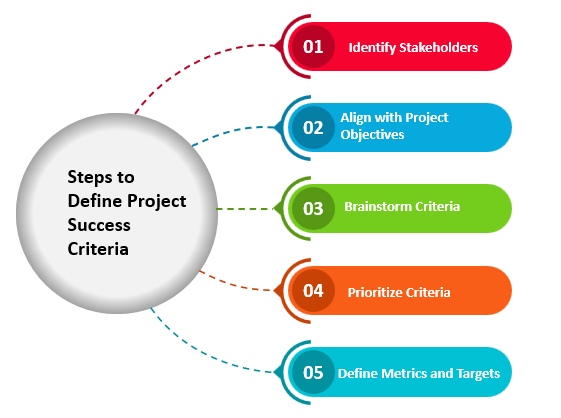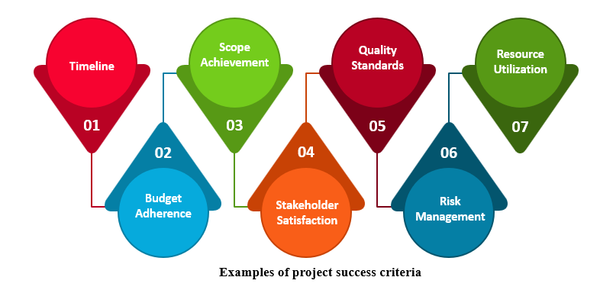How To Define Project Success Criteria Examples, Steps ?
In today's dynamic business landscape, successful project execution is crucial for organizations aiming to achieve their strategic goals. However, determining what constitutes project success can be a complex and multifaceted task. To ensure clarity and alignment throughout the project lifecycle, defining project success criteria becomes paramount. These criteria act as a yardstick against which the project's achievements and outcomes are measured. In this article, we will explore examples of project success criteria and outline the steps involved in effectively defining them.

Steps To Define Project Success Criteria:
- Identify Stakeholders: Identify and engage key stakeholders, including project sponsors, clients, team members, and end-users, to understand their expectations and perspectives on project success.
- Align With Project Objectives: Review the project's objectives and strategic goals to ensure that the success criteria are aligned with the desired outcomes.
- Brainstorm Criteria: Conduct brainstorming sessions or workshops with relevant stakeholders to generate a comprehensive list of potential success criteria based on the project's unique requirements and context.
- Prioritize Criteria: Analyze and prioritize the generated success criteria, considering factors such as feasibility, relevance, and impact on project success.
- Define Metrics And Targets: Develop measurable metrics and targets for each success criterion, enabling objective evaluation and monitoring of project progress.
Defining Project Success Criteria – Why Is It Important?
- Clarity And Alignment: Project success criteria provide clarity and ensure that all stakeholders have a shared understanding of what defines project success. They align everyone's expectations and goals, reducing ambiguity and increasing focus on achieving specific outcomes.
- Measurement And Evaluation: Success criteria act as measurable benchmarks against which project performance can be evaluated. They enable objective assessment of the project's progress and achievements, allowing stakeholders to gauge whether the project is on track and meeting its intended goals.
- Decision-Making And Prioritization: Clearly defined success criteria help project managers make informed decisions and prioritize activities. They provide a framework for allocating resources, setting priorities, and making trade-offs to ensure that efforts are directed towards achieving the most critical project objectives.
- Stakeholder Satisfaction: Project success criteria take into account the expectations and requirements of key stakeholders. By defining and meeting these criteria, project managers can enhance stakeholder satisfaction and build stronger relationships with clients, sponsors, team members, and other relevant parties.
Examples Of Project Success Criteria :
- Timeliness: The project is completed within the agreed-upon timeline or before critical deadlines.
- Budget Adherence: The project is completed within the allocated budget, and financial resources are effectively managed.
- Scope Achievement: All project requirements and deliverables, as defined in the project scope, are successfully met.
- Stakeholder Satisfaction: The project meets or exceeds the expectations of key stakeholders, such as clients, sponsors, end-users, or regulatory bodies.
- Quality Standards: The project delivers a high-quality outcome that meets predefined standards and specifications.
- Risk Management: The project effectively identifies, mitigates, and manages risks throughout its lifecycle, minimizing their impact on project success.
- Resource Utilization: Project resources, including personnel, equipment, and materials, are optimally utilized, ensuring efficiency and avoiding resource wastage.
Steps To Define Project Success Criteria :
- Identify Stakeholders: Identify and engage key stakeholders, including project sponsors, clients, team members, and end-users. Understand their perspectives, expectations, and desired outcomes related to the project. Stakeholder input is crucial for determining the criteria that will be used to measure project success.
- Align With Project Objectives: Review the project's objectives and strategic goals. Ensure that the success criteria align with and support these objectives. The success criteria should directly contribute to the overarching goals of the project and reflect the desired outcomes.
- Brainstorm Criteria: Conduct brainstorming sessions or workshops involving relevant stakeholders. Generate a comprehensive list of potential success criteria based on the project's unique requirements, objectives, and stakeholder expectations. Encourage open and collaborative discussions to gather diverse perspectives.
- Prioritize Criteria: Analyze and prioritize the generated success criteria. Consider factors such as feasibility, relevance, measurability, and impact on project success. Identify the most critical success criteria that will provide meaningful insights into the project's progress and outcomes.
- Prioritize Criteria: Analyze and prioritize the generated success criteria. Consider factors such as feasibility, relevance, measurability, and impact on project success. Identify the most critical success criteria that will provide meaningful insights into the project's progress and outcomes.
- Define Metrics And Targets: Develop measurable metrics and targets for each success criterion. Metrics should be specific, quantifiable, and time-bound, enabling objective evaluation and monitoring of project progress. Targets help set benchmarks against which project performance can be measured.
- Document And Communicate: Document the defined project success criteria in a clear and concise manner. Create a formal document or project charter that outlines the success criteria, metrics, and targets. Ensure that all stakeholders have access to and a shared understanding of the defined criteria. Communicate the success criteria widely to foster transparency and alignment.
Common Pitfalls To Avoid When Defining Project Success Criteria
- Vague Or Ambiguous Criteria: Avoid using ambiguous or subjective language when defining success criteria. Ensure that the criteria are specific, measurable, attainable, relevant, and time-bound (SMART) to provide clarity and avoid misinterpretation.
- Lack Of Stakeholder Involvement: Failing to involve key stakeholders in the process of defining success criteria can result in misalignment and unrealistic expectations. Engage stakeholders from the early stages to gather their input, understand their perspectives, and ensure their buy-in.
- Overlooking Key Dimensions: Ensure that success criteria cover all relevant dimensions of the project. Consider not only schedule, budget, and scope but also quality, stakeholder satisfaction, risk management, resource utilization, and other key aspects specific to your project.
- Neglecting Objective Metrics: Success criteria should be based on objective metrics that can be measured and evaluated. Avoid relying solely on subjective opinions or perceptions. Use quantifiable measures whenever possible to ensure accurate assessment of project performance.
- Setting Unrealistic Or Unattainable Targets: Be realistic when setting targets for success criteria. Setting unattainable or overly ambitious targets can demotivate the project team and undermine the credibility of the success criteria. Ensure that targets are challenging yet achievable within the project's constraints.

Implementing Project Success Criteria In Your Organization
- Define Organizational Success Criteria: Start by defining a set of standardized success criteria that align with the organization's strategic objectives. These criteria should be applicable to various projects within the organization. Consider key dimensions such as timeliness, budget adherence, quality, stakeholder satisfaction, and overall business value.
- Customize Success Criteria For Each Project: While organizational success criteria provide a baseline, each project may have unique requirements and objectives. Tailor the standardized criteria to suit the specific context and goals of each project. Engage project stakeholders to ensure that the success criteria are relevant and meaningful to their project.
- Integrate Success Criteria Into Project Planning: Incorporate the defined success criteria into the project planning process. Ensure that they are included in project charters, scope documents, and other planning artifacts. This integration ensures that the success criteria are considered from the outset and guide project decision-making.
- Communicate And Train: Communicate the importance of project success criteria to project teams and stakeholders. Provide training and guidance on how to define, track, and evaluate success criteria effectively. Foster a shared understanding of the criteria and their relevance to project success.
Conclusion :
In conclusion, defining project success criteria is a critical process that sets the foundation for achieving project goals and ensuring successful outcomes. By following the steps outlined above, organizations can establish clear and measurable criteria that align with their objectives and stakeholder expectations. Through the identification of relevant success criteria, such as timeliness, budget adherence, stakeholder satisfaction, and quality standards, organizations can monitor and evaluate project progress effectively.



